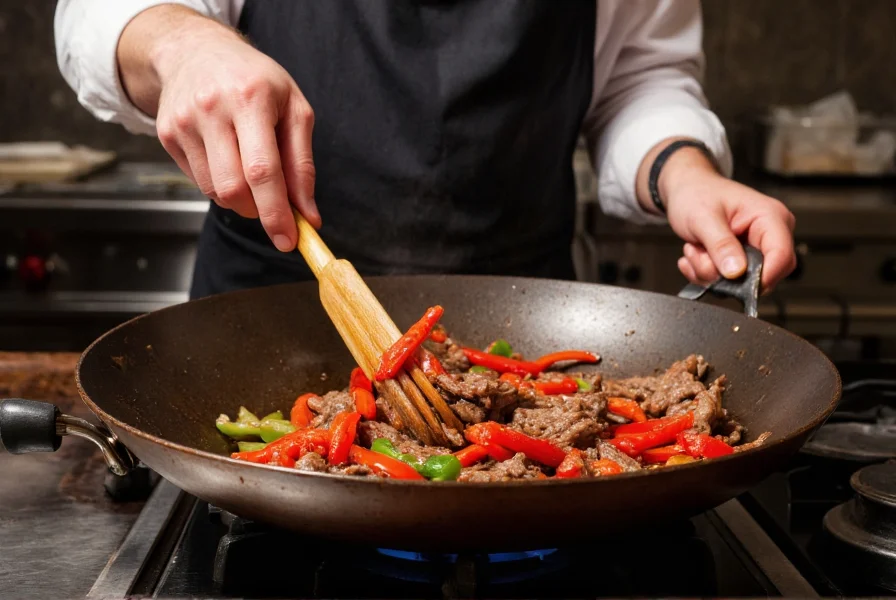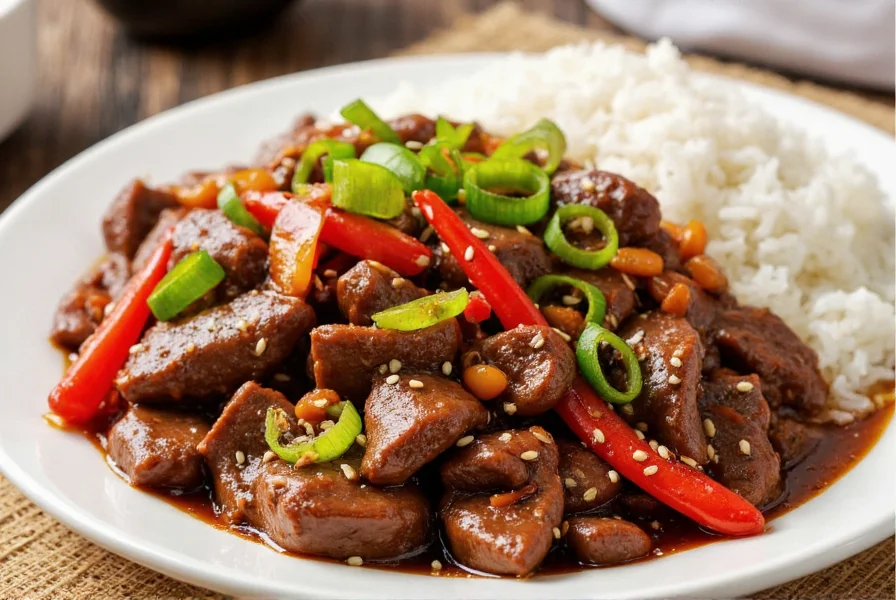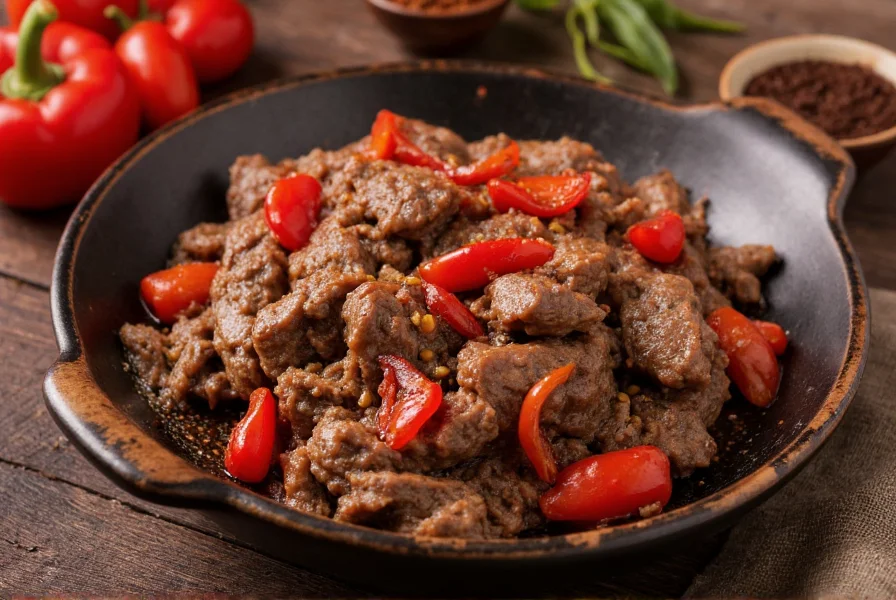One of the most beloved dishes in American-Chinese cuisine, Chinese Pepper Beef delivers the perfect balance of savory, sweet, and slightly tangy flavors with satisfying crunch from fresh bell peppers. Unlike its cousin Mongolian Beef, which features a heavier brown sauce, Pepper Beef maintains a lighter profile that showcases the quality of the beef and freshness of the vegetables.
The Origins of Chinese Pepper Beef
While not found in traditional Chinese regional cuisines, Pepper Beef emerged from Chinese-American culinary innovation during the mid-20th century. Chinese immigrants adapted their cooking techniques to incorporate ingredients more readily available in America, creating dishes that appealed to local palates while maintaining essential Chinese cooking principles like the "wok hei" (breath of the wok) flavor developed through high-heat stir-frying.
Essential Ingredients for Authentic Flavor
The magic of Chinese Pepper Beef lies in its carefully balanced ingredients. Each component serves a specific purpose in creating the dish's signature taste and texture.
| Ingredient | Function | Key Substitutes |
|---|---|---|
| Flank steak (1 lb) | Provides tender, flavorful beef when sliced properly against the grain | Sirloin, ribeye, or chicken for alternative protein |
| Red bell peppers (2) | Adds sweetness and vibrant color with ideal crunch | Yellow or orange peppers; avoid green for sweeter profile |
| Soy sauce (3 tbsp) | Creates umami base; use low-sodium for better control | Coconut aminos for gluten-free option |
| Rice vinegar (1 tbsp) | Adds necessary acidity to balance sweetness | Apple cider vinegar in pinch |
| Cornstarch (2 tbsp) | Thickens sauce and creates velvety coating on beef | Arrowroot powder for similar effect |
Professional-Grade Cooking Technique
What separates restaurant-quality Chinese Pepper Beef from ordinary home attempts comes down to technique rather than exotic ingredients. The three-step process ensures perfect results every time:
- Velveting the beef: Marinate sliced beef with 1 tbsp soy sauce, 1 tbsp rice wine, 1 tsp cornstarch, and 1 tsp oil for 20-30 minutes. This creates a protective layer that keeps the meat tender during high-heat cooking.
- High-heat stir-frying: Heat your wok or skillet until smoking hot before adding oil. Cook beef in single layer for 90 seconds until just browned but not fully cooked, then remove. Stir-fry vegetables for 2-3 minutes until crisp-tender.
- Sauce integration: Return beef to wok, add prepared sauce (2 tbsp soy sauce, 1 tbsp rice vinegar, 1 tbsp brown sugar, 1 tsp sesame oil, 1 tbsp cornstarch mixed with ¼ cup broth), and cook 60-90 seconds until glossy and thickened.

Avoiding Common Pitfalls
Even experienced home cooks make these critical mistakes when preparing Chinese Pepper Beef:
- Overcrowding the pan: Adding too much beef at once lowers the temperature, causing steaming instead of searing. Cook in batches for proper browning.
- Using pre-sliced "stir-fry" beef: These often contain tenderizers that create an unpleasant texture. Slice your own against the grain for optimal results.
- Adding vegetables too early: Bell peppers should retain some crunch. Add them after the beef has been removed from the wok.
- Overcooking the sauce: The cornstarch thickens rapidly at the end. Remove from heat immediately when the sauce coats the back of a spoon.
Serving and Pairing Recommendations
For the most authentic Chinese Pepper Beef experience, serve immediately over steamed jasmine rice. The dish pairs exceptionally well with:
- Light vegetable sides like Chinese broccoli or snow pea shoots
- A crisp Asian-style slaw for textural contrast
- Hot mustard or chili oil on the side for those who prefer additional heat
Leftovers (if any remain) should be stored in an airtight container for up to three days. When reheating Chinese Pepper Beef, use a skillet over medium heat with a splash of water rather than a microwave to preserve texture. The sauce may thicken upon refrigeration, so add a teaspoon of broth or water while reheating.
Regional Variations Worth Trying
While the American-Chinese version dominates restaurant menus, several regional adaptations offer interesting twists:
- Szechuan style: Adds dried red chilies and Szechuan peppercorns for distinctive numbing heat
- Hong Kong variation: Incorporates oyster sauce and black bean paste for deeper umami
- Health-conscious version: Uses reduced-sodium tamari and increases vegetable-to-beef ratio
- Vegan adaptation: Substitutes seitan or mushrooms for beef while maintaining the sauce profile

Why This Dish Endures in American-Chinese Cuisine
Chinese Pepper Beef remains popular because it perfectly balances accessibility with authentic technique. Unlike some Americanized Chinese dishes that stray far from traditional cooking, Pepper Beef maintains core Chinese culinary principles while adapting to available ingredients. The dish showcases the Chinese cooking philosophy of "yi cai yi ge" (each dish has its own style) by highlighting specific ingredients rather than masking them with heavy sauces.
Mastering Chinese Pepper Beef provides a foundation for exploring other stir-fry dishes. Once you understand the proper heat management, ingredient preparation, and sauce balancing required for this dish, you'll find it easier to recreate many other Chinese restaurant favorites at home with professional results.
What cut of beef works best for Chinese Pepper Beef?
Flank steak is ideal for Chinese Pepper Beef because it has excellent beefy flavor and slices well against the grain into tender strips. When properly sliced thinly across the grain, flank steak provides the perfect texture. Alternatives include sirloin tip or flat iron steak, but avoid tougher cuts like chuck that won't tenderize sufficiently with quick cooking methods.
How can I make Chinese Pepper Beef without a wok?
You can successfully make Chinese Pepper Beef using a heavy-bottomed cast iron or carbon steel skillet. The key is heating your pan until extremely hot before adding oil (it should shimmer immediately). Use high heat throughout cooking and avoid overcrowding the pan. A large, deep frying pan with sloped sides works nearly as well as a traditional wok for stir-frying.
What's the difference between Chinese Pepper Beef and Mongolian Beef?
Chinese Pepper Beef features bell peppers as a primary ingredient with a lighter, more balanced sauce containing vinegar for brightness. Mongolian Beef typically has no vegetables in the main dish and uses a heavier, sweeter brown sauce with more sugar and less acidity. Pepper Beef highlights the beef and vegetables, while Mongolian Beef focuses on the rich sauce coating the meat.
Can I prepare Chinese Pepper Beef ahead of time?
For best results, Chinese Pepper Beef should be served immediately after cooking. However, you can prepare components ahead: slice and marinate the beef (up to 24 hours in advance), cut vegetables (store in airtight container for 2 days), and make the sauce (refrigerate for up to 3 days). The quick cooking process means you can have the complete dish ready in under 20 minutes when needed.
Why does my homemade Chinese Pepper Beef taste different from restaurant versions?
Restaurant versions often use higher heat than home stoves can achieve, creating superior "wok hei" flavor. They may also use commercial meat tenderizers and higher sodium levels. To bridge the gap, ensure your pan is extremely hot before cooking, use proper cornstarch velveting technique, and consider adding a small amount of baking soda (⅛ tsp) to the beef marinade to help with tenderizing without altering flavor significantly.











 浙公网安备
33010002000092号
浙公网安备
33010002000092号 浙B2-20120091-4
浙B2-20120091-4